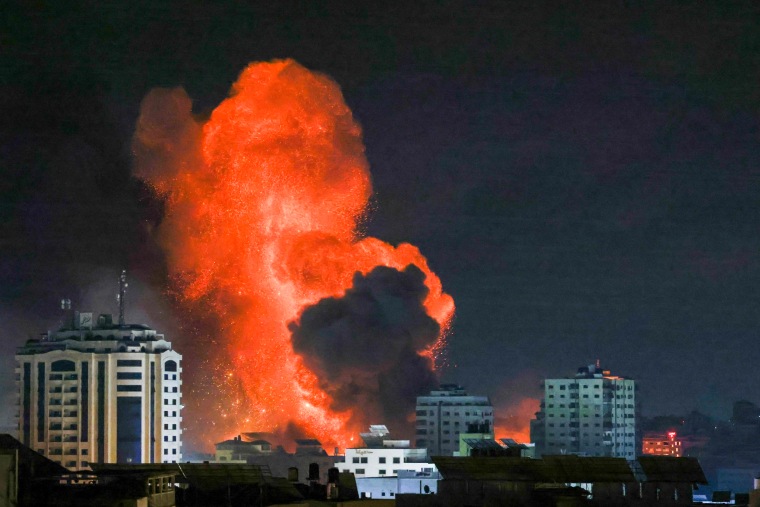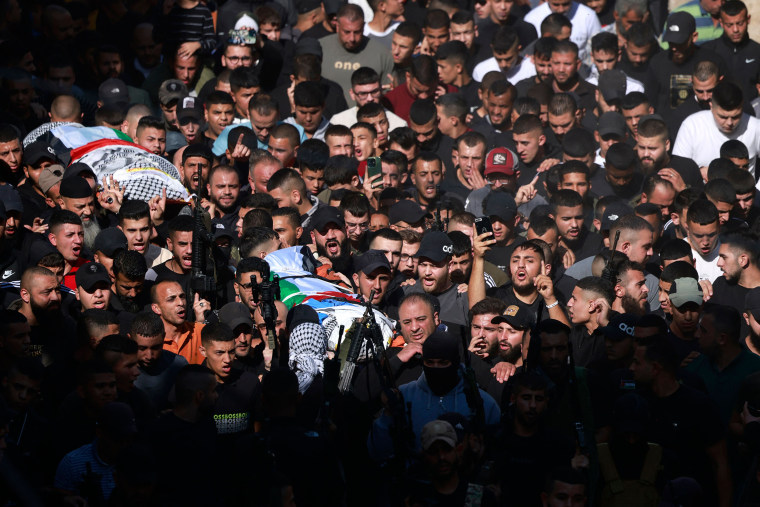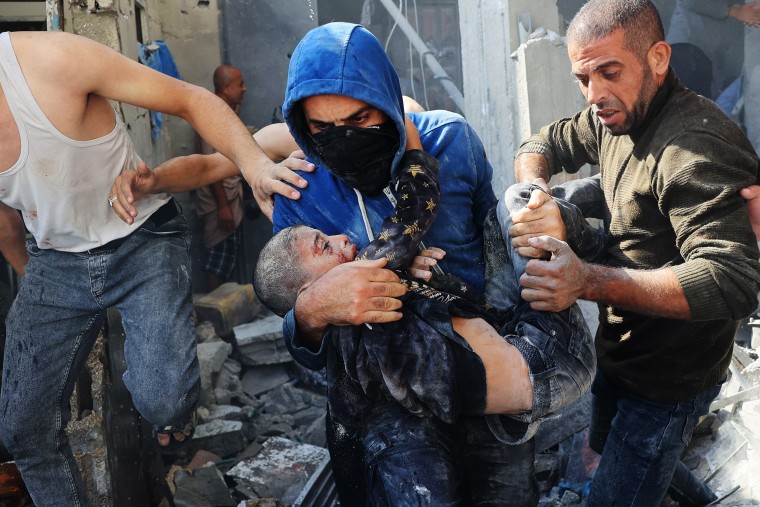Day and night, according to Palestinians, a sound echoes above Khan Younis, the largest city in southern Gaza. The noise isn’t the detonation of a bomb dropped by an Israeli jet. It’s the low hum of Israeli drones circling overhead.
“They never leave the sky,” Tareq Hajjaj, a freelance Palestinian journalist, said via WhatsApp.
As civilians flee northern Gaza, the focus of international attention — and the fears of many Palestinians — is how Israel may wage war in southern Gaza. The focus, in particular, is on airstrikes.
Israeli officials, including two active-duty drone pilots, said they follow exacting procedures to minimize civilian casualties. An Israel Defense Forces military attorney must sign off on every strike after a review of intelligence. And pilots must conduct real-time analyses of potential civilian deaths.
“We preplan what happens if children enter into our area,” said one of the drone pilots, referring to calling off a strike. “We preplan what happens if the terrorists launch a rocket and then drive into a crowded area, as they so often do.”
Critics of Israel’s tactics say the sheer volume of airstrikes it has conducted in such densely populated areas is worrying. In the first week of the conflict, which began after Hamas’ Oct. 7 terrorist attack killed more than 1,200 Israelis, the IDF dropped 6,000 bombs in Gaza. In 2019, the U.S. dropped 7,400 bombs in Afghanistan over the course of an entire year.

Professor Janina Dill, a co-director of Oxford University’s Institute for Ethics, Law and Armed Conflict, said she is concerned Israel might be violating international law.
She cited the number of airstrikes, the reported deaths of 13,000 Palestinians and statements by Israeli officials that she said suggested they believed that not all Palestinian civilians deserve protection.
“If we take these three things together,” Dill said, “then it’s really difficult to believe that all airstrikes here comply with international humanitarian law.”
Since disclosing the number of airstrikes it carried out during the war's first week, the IDF has declined to say how many bombings it has conducted. An Israeli official who asked not to be named said he couldn’t disclose whether jets or drones carry out the majority of the Israeli strikes.
“A lot of the things in Gaza are unmanned aircraft, and some of the things are not,” he said.
Last week, Human Rights Watch accused the Israeli military of "repeated, apparently unlawful attacks on medical facilities" and said they "should be investigated as war crimes." Israeli officials accuse Hamas of building command centers beneath hospitals.
The Biden administration, meanwhile, has provided little information regarding the accuracy of Israeli airstrikes, while closely monitoring and condemning Russian attacks that kill Ukrainian civilians.
With war crimes investigators and international journalists unable to operate independently in Gaza, United Nations officials and open-source data researchers say the full details of Israel’s bombing campaign remain largely unknown. “It’s really tricky,” said a researcher who asked not to be named. “It’s difficult to tell.”
‘War is terrible’
IDF officials granted NBC News access to an Israeli military drone base south of Tel Aviv and provided interviews with two active-duty Israeli drone pilots. Israeli officials requested that the pilots remain anonymous because the IDF considers their identities classified.
The pilots declined to discuss specific targets, but Israel's strikes in Gaza appear to be focused on two things: undermining Hamas capabilities, such as rocket launching, and killing the senior leadership of Hamas, which is more difficult because of the group’s extensive underground tunnel system.
The pilots described how they try to minimize civilian casualties when they carry out strikes. They also said they were aware of the controversy surrounding Israeli air attacks.
“War is terrible. It’s filled with chaos. And when the other side, Hamas, is using civilians as human shields, it makes our jobs 100 times worse,” said the first of the two pilots.
“We’re an integral part of the battle and the battlefield,” the first pilot added. “We take full responsibility for anything that goes on.”
The other pilot said, “Our job is to make sure that whoever needs to be eliminated is taken out exclusively and no one else.”

A strike in the West Bank
Drone strikes in the conflict aren’t limited to Gaza. On Saturday, NBC News visited a damaged Palestinian Authority Fatah party building in the Balata refugee camp, near Nablus, in the West Bank. The drone strike Friday appeared to have created a hole in its ceiling.
The IDF said it had targeted a “hide-out used by terrorists,” and both the IDF and residents said a member of the armed wing of Fatah was killed. Residents said five people, in all, died in the bombing.
One of them was a man walking by the building, according to witnesses. Another was a 15-year-old boy who died inside it. An interview with his mother that was posted online said he was at his grandfather’s house and then went to the Fatah center before the strike occurred. “My fate,” his mother said, “was to become the mother of a martyr.”
On Saturday, the bodies of the dead were covered in flags and carried through the streets by crowds of men, some masked and firing automatic weapons in the air. A mobile sound system played songs celebrating Palestinian fighters.
During the funeral, a drone could be seen flying overhead. “Even after the bombing, it’s still roaming around,” a man said. “It monitors everything in the area.”
‘I see children’
It takes two people to fly a weaponized drone: the pilot of the drone and a second person who operates the “ball,” handling the signals intelligence and imagery.
IDF officials gave NBC News exclusive access to five videos showing what Israeli drone pilots saw surveilling possible targets in Gaza during the first weeks of the war.
In the videos, two IDF pilots discuss whether or not to strike. They talk about people, sometimes children, walking close enough to targets that they choose to cancel the strikes or delay them until civilians have left the area.
“There are at least six or seven people wandering the area of the school wearing black. One, two, three, four, five, six, seven,” an IDF pilot counts in Hebrew. The black and white video shows dark gray images that appear to be people moving on the ground below.
Another IDF pilot refers to an area that comes into view and says in Hebrew, “I estimate there are 10 here at least, even 20 or 30. I am mentioning again, we think this is not within the policy.”
In a second video, an IDF pilot is heard saying, “I see children right beside the building.” Later in the video, another pilot asks, “Could you show me where the children are?” The first pilot replies: “Now it’s out of our eyesight. We can’t see, but in the area that I’m marking, in that space, there are many people, including children.” At the end of the video, a pilot says: “We are leaving this target. It isn’t approved.”
One of the drone pilots interviewed by NBC News said such conversations were common. “We have to stay sharp,” he said. “That’s why we are constantly speaking about the children at the scene and whoever or whatever gets into our picture and why we have to abort airstrikes and call off airstrikes.”
The principles of war
U.S. Army Lt. Col. Paul Lushenko, a co-author of the forthcoming book “The Legitimacy of Drone Warfare: Evaluating Public Perceptions,” reviewed the five Israeli drone videos for NBC News.
“First and foremost, this is a complicated business set against the sort of terrain that we’re operating within,” he said, referring to Gaza. “You can see how congested, contested and built-up it is.”
He said international humanitarian law requires combatants to abide by the principles of distinction (between civilians and combatants), proportionality (the use of commensurate force) and military necessity (the need to achieve a legitimate military objective). The rules apply to both ground operations and airstrikes, including drone attacks.
Lushenko said drone strikes conducted by Israel have most likely resulted in civilian casualties — though probably fewer than would be caused by large bombs dropped by planes — and that the deaths may have been unintentional.

“Make no mistake: International humanitarian law is put in place to minimize collateral damage, especially the killing of women and children,” Lushenko said. “But it doesn’t preclude it in the event that you have an overriding military objective.”
Israeli ethicists, professors and experts said international humanitarian law is integrated into IDF operations: commanders’ and soldiers’ guidelines and orders, their training and real-time legal advice.
“There are on-site, hands-on military attorneys who operate at every level from the Israeli chief of staff to the units that operate on the ground,” said Netta Barak-Corren, a professor at Hebrew University in Jerusalem and a fellow at Princeton University. “They are there to assist the military commander by giving advice in real time about whether a specific operation is legal under international humanitarian law or not.”
The IDF’s code of ethics also includes a clause explicitly stating that members of the military will not use their weapons to harm civilians.
One of the authors of the IDF code of ethics, Moshe Halbertal, an adviser to the IDF, said the code applies to drones. “Drones are operated by humans, and they have to take care while operating a drone,” said Halbertal, a professor at Hebrew University and New York University Law School.
Dill, the Oxford University professor, said she worried that commanders may rely too heavily on drone strikes in order to minimize their own troop losses. They may also attempt attacks they would not conduct on the ground.
“The disadvantage is that they give commanders the notion that ... they can target anywhere, and so maybe sometimes they bring targets within reach that would otherwise not have been attacked,” she said. “The ethical and legal upside is that they allow the commander to keep their own forces out of harm’s way.”
‘War is messy’
The Israeli drone pilots acknowledged the dangers of their strikes. “I can say that war is messy, and we can train all day and all night not to hit civilians,” one said. “When it happens, we as IDF soldiers take it very hard, understanding that we have to be better next time and be more precise. And that’s what we train to do.”
The other pilot said: “Our moral code and moral high ground only takes us to some point. And it’s hard; it’s difficult. It’s unbelievably tricky.”
Hajjaj, the Palestinian freelance journalist in southern Gaza, said people there fear what comes next. He said it seemed that larger targets like buildings were being hit with bombs dropped by Israeli F-16s or other planes. Drones, meanwhile, continue to circle overhead, emitting a low hum.
“The noise prevents us to sleep, prevents us to speak and prevents us to hear well,” Hajjaj said.

